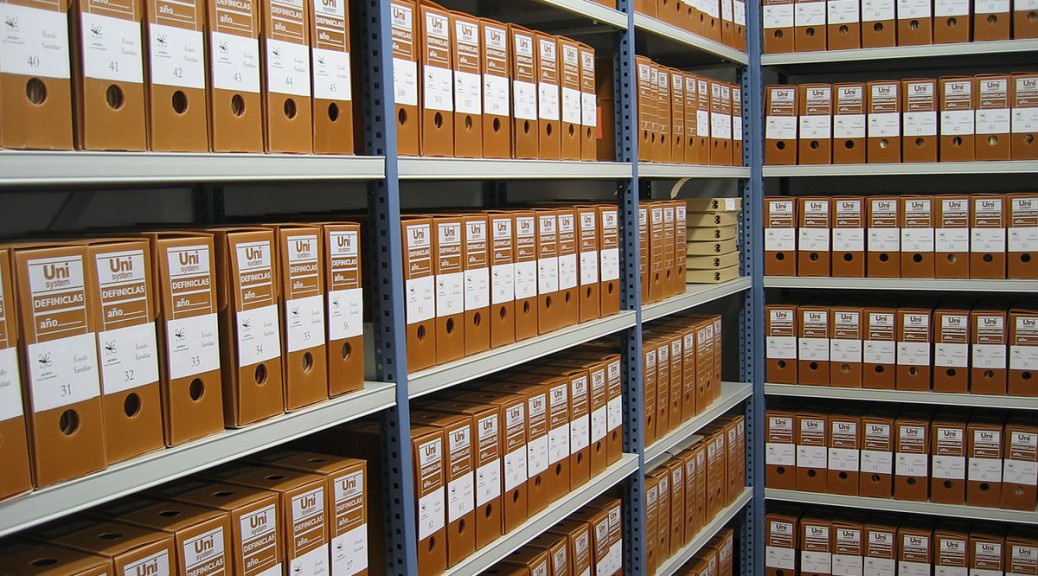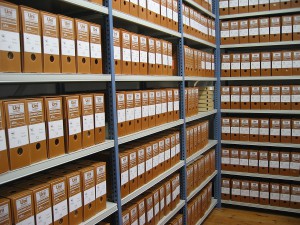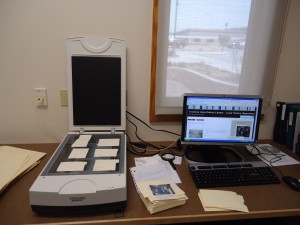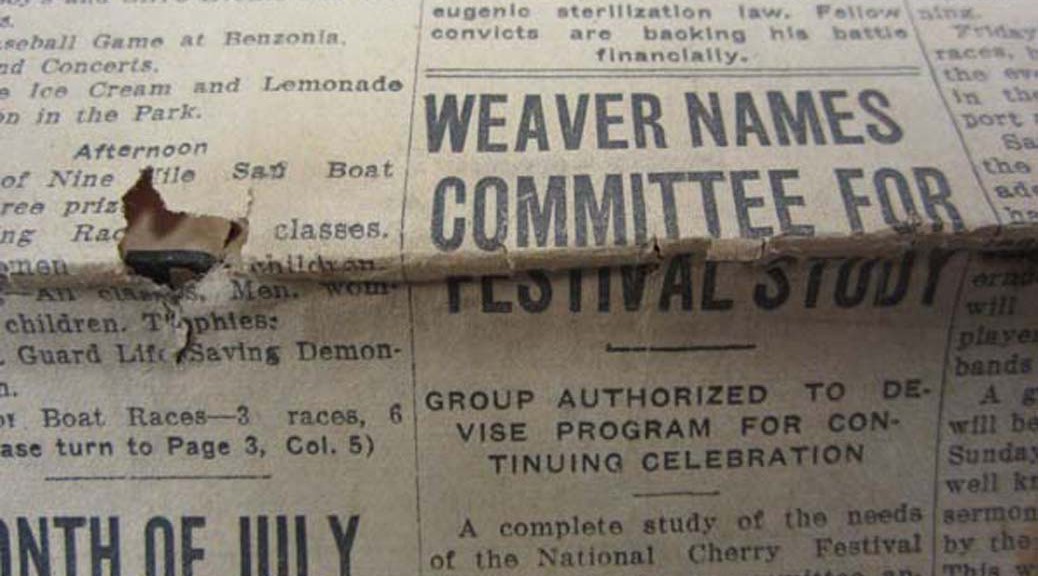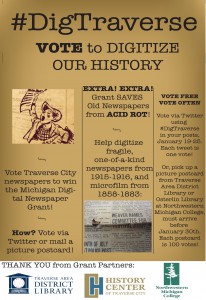In honor of all the architects who have built Traverse City, and their buildings that have been demolished in the name of progress.
by Julie Schopieray

The city’s landmark Park Place Hotel has undergone many changes over its long history. The first major change was the construction of the building we all know today. After standing for more than fifty-five years, the 1873 hotel first known as the Campbell House was replaced in the name of progress. In 1929, R. Floyd Clinch, president of the Hannah & Lay Corporation, hired prominent Chicago architect, Benjamin H. Marshall to design a new, modern 9-story structure. Since then, the hotel has had several owners, gone through many renovations and has struggled with financial difficulties, yet it has survived. It is once again considering another dramatic change.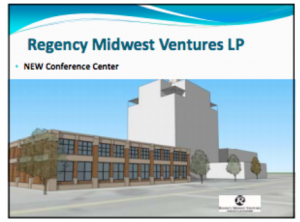
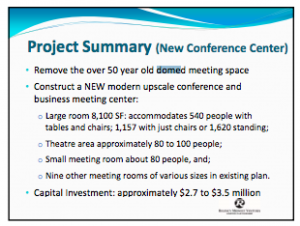
Among several controversial development proposals currently being discussed in the city is a new conference center attached to the Park Place Hotel. This development would involve demolishing two mid-century buildings, including the 1965 Park Place Dome. Before this happens, it is important to inform and remind the public of the significance of this building, both architecturally and historically. Some will question whether a mid-century structure could be considered historically significant– it’s only fifty years old. Many may look at the Dome building and think it isn’t worth saving because honestly, it may not be the most attractive building in town. But, do they know that when it was built, it was ground-breaking technology?
By the early 1960s, it was determined that the city needed a convention hall. A couple sites were proposed, but the overwhelming opinion was that it should be located in the downtown area. At first, a city-owned hall was proposed in cooperation with the Park Place Hotel, but the bonds were voted down. That plan changed when the financially strapped hotel was sold In December 1963, to Traverse City native Eugene Power of Ann Arbor. Under his ownership, it would be re-opened under the name, Park Place Motor Inn. He was determined that the updates he planned would once again draw tourists and conventions to the hotel and stated that “all-out efforts will be made to re-build the convention business” [Traverse City Record-Eagle, 5 December 1963].
But first, the thirty-five-year-old hotel needed to be brought up to date. The expansion proposal was not without controversy. It included the need to close to through traffic, the section of Park Sreet that ran between State and Washington streets. At first, there was strong opposition and the city commission denied the request. It would mean the few remaining structures on that section of Park Street would become “land-locked” and lose value. It also drew criticism from the representatives of the three churches on Washington Street whose congregations used the street. Eventually, compromises were made which freed up the hotel to complete their  plans. By January 1964, the renovations were finally under way. Power’s goal was to make the inn once again, “a credit to Traverse City.” [Traverse City Record-Eagle, 5 December 1963]. He hired local architect Paul Hazelton and the extensive updates were prepared. Hazelton first designed a 100-room motel addition replacing the old Annex building. The raised building allowed for doubling the parking for the hotel. Other improvements included a top floor dining room and cocktail lounge, a complete redesign of the lobby and a dining room, a bar, coffee shop, room renovations, indoor competition-type swimming pool and eventually a convention hall. The convention center was the last structure to be added. For that, Hazelton conceived an extraordinary design. It complemented the unique dome which covered the swimming pool. It was to be circular in shape
plans. By January 1964, the renovations were finally under way. Power’s goal was to make the inn once again, “a credit to Traverse City.” [Traverse City Record-Eagle, 5 December 1963]. He hired local architect Paul Hazelton and the extensive updates were prepared. Hazelton first designed a 100-room motel addition replacing the old Annex building. The raised building allowed for doubling the parking for the hotel. Other improvements included a top floor dining room and cocktail lounge, a complete redesign of the lobby and a dining room, a bar, coffee shop, room renovations, indoor competition-type swimming pool and eventually a convention hall. The convention center was the last structure to be added. For that, Hazelton conceived an extraordinary design. It complemented the unique dome which covered the swimming pool. It was to be circular in shape 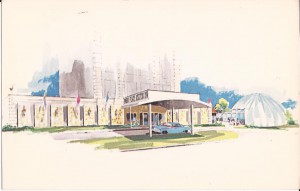 and covered by an 80‘ dome. When the plan was revealed, an article in the paper described the new Park Place Dome as “A world ‘first’ in architecture,” as the roof of the building was being constructed of a material never used before. Hazelton described it as “a completely new concept in world building history.” He was working with Dow Chemical Company engineer Donald Wright, who developed the lightweight plastic styrofoam that covered the building. Wright came up with the idea and worked on the project in secret for several years before he and Hazelton convinced Eugene Power to give the go-ahead on the
and covered by an 80‘ dome. When the plan was revealed, an article in the paper described the new Park Place Dome as “A world ‘first’ in architecture,” as the roof of the building was being constructed of a material never used before. Hazelton described it as “a completely new concept in world building history.” He was working with Dow Chemical Company engineer Donald Wright, who developed the lightweight plastic styrofoam that covered the building. Wright came up with the idea and worked on the project in secret for several years before he and Hazelton convinced Eugene Power to give the go-ahead on the 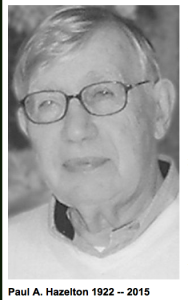 experimental project. Hazelton explained that it was the first time a plastic was actually used as a “structural form rather than as a cover supported by some other material.” It took only about 12 hours to place the dome on top of the structure. The architect continued by explaining that “the unique use of plastic has tremendous potential for future building throughout the world. It is ‘monolithic’ in that one material is used, the process is fast, the structure is easy to maintain and repair, and the overall cost can be as little as one third that for conventional construction” [Traverse City Record-Eagle, 24 October 1964]. The dome weighed only two pounds per cubic foot, compared to concrete which would have weighed 150 pounds per cubic foot. Even though the dome was experimental at the time, it has withstood fifty years of use.
experimental project. Hazelton explained that it was the first time a plastic was actually used as a “structural form rather than as a cover supported by some other material.” It took only about 12 hours to place the dome on top of the structure. The architect continued by explaining that “the unique use of plastic has tremendous potential for future building throughout the world. It is ‘monolithic’ in that one material is used, the process is fast, the structure is easy to maintain and repair, and the overall cost can be as little as one third that for conventional construction” [Traverse City Record-Eagle, 24 October 1964]. The dome weighed only two pounds per cubic foot, compared to concrete which would have weighed 150 pounds per cubic foot. Even though the dome was experimental at the time, it has withstood fifty years of use.
The innovative concepts used in the design are important to our town’s history. At the time, this building was seen as a much needed step forward and was built to improve not only the hotel but the community as well. If we are to lose this unique structure, we, at the very least, need to remember the significance it held for our city just one generation ago.
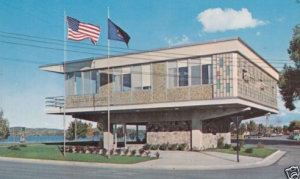
As a side note about the architect: Paul Hazelton is also well known as the architect for the 1965 Chamber of Commerce building which was replaced with a new structure in 2001. His 1957 design of the Oleson’s food store on State Street won an award for Architectural Achievement of Merit from the Western Michigan Chapter of the American Institute of Architects. He also designed the 1969 airport terminal. It was the first building (and only) in town to have an escalator– another of Hazelton’s many “firsts” in Traverse City architecture. That building was demolished in 2007 to make way for a new terminal.
You will be able to read more about the architecture of Traverse City in an upcoming book by Julie Schopieray, author and regular contributor to Grand Traverse Journal.


